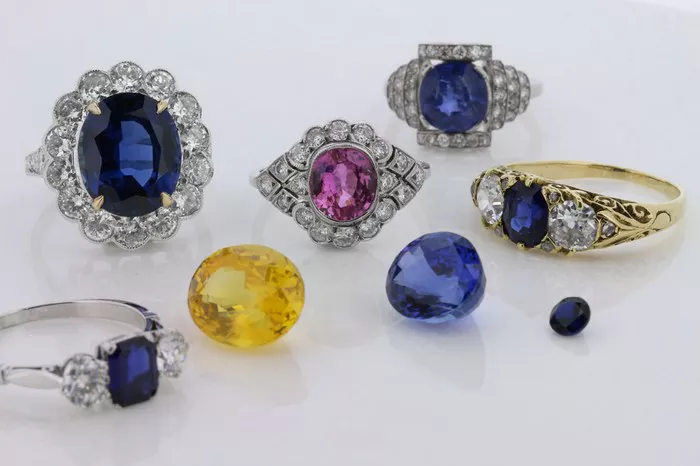Jewelry has been an integral part of human culture for thousands of years, serving as symbols of status, power, beauty, and personal style. Among the myriad of gemstones available, rubies and sapphires stand out due to their rich history, stunning appearance, and significant symbolic meanings. While rubies are known for their vibrant red hues, sapphires encompass a wide range of colors, including the striking yellow variety. This article explores whether rubies and yellow sapphires can be worn together, delving into their physical properties, cultural significance, compatibility in jewelry design, and care tips.
Physical Properties and Composition
Ruby and sapphire share a common mineral origin: they are both varieties of the mineral corundum. Corundum is an aluminum oxide (Al₂O₃) crystal that occurs naturally in various colors due to trace impurities. Ruby is specifically defined as any red-colored corundum, while sapphire refers to all other colors of corundum.
Ruby
Color: Ranges from deep red to pinkish red, with the most valuable color being a vivid, almost purplish red known as “pigeon’s blood.”
Hardness: Rates 9 on the Mohs scale of mineral hardness, making it one of the hardest natural gemstones.
Clarity: Can contain inclusions such as silk, needles, or liquid-filled cavities, which can affect its transparency and value.
Source: Predominantly mined in Myanmar (Burma), Sri Lanka, Thailand, Vietnam, and Madagascar.
Yellow Sapphire
Color: Ranges from pale yellow to a vivid, golden hue. The most desired yellow sapphires exhibit a strong, even color saturation.
Hardness: Also rates 9 on the Mohs scale, ensuring durability.
Clarity: Similar to ruby, yellow sapphires can have varying degrees of clarity, with some being nearly transparent and others containing noticeable inclusions.
Source: Primary sources include Sri Lanka, Myanmar, Madagascar, and Australia.
Cultural Significance
Rubies and sapphires have been revered throughout history for their mystical and symbolic properties.
Ruby
Symbolism: Ruby is often associated with love, passion, and vitality. It is considered the birthstone for July and is believed to bring good fortune and health to its wearer.
History: Ruby has been cherished in many cultures, including ancient India, where it was thought to symbolize wisdom and prosperity. In Europe, it was worn by royalty as a symbol of power and divinity.
Yellow Sapphire
Symbolism: Yellow sapphire is associated with wisdom, prosperity, and good fortune. It is considered the birthstone for September and is believed to enhance creativity and clarity of thought.
History: In Hindu mythology, yellow sapphire (or pukhraj) is sacred and believed to have protective powers. It is often worn by those seeking success in business, academics, or relationships.
Compatibility in Jewelry Design
When considering whether rubies and yellow sapphires can be worn together, it’s essential to examine their aesthetic compatibility and the potential design opportunities they offer.
Color Combination
The combination of red and yellow is visually striking and creates a warm, inviting palette. Ruby’s vibrant red contrasts beautifully with yellow sapphire’s golden hues, making for a visually dynamic duo.
This color combination can be used to create bold, statement pieces or more subtle, elegant designs.
Design Ideas
Rings: A ring featuring a ruby as the central stone surrounded by smaller yellow sapphires can create a stunning, regal look. Alternatively, a yellow sapphire ring with ruby accents can add a pop of color and contrast.
Pendants: A pendant with a ruby pendant drop and yellow sapphire accents, or vice versa, can make for a beautiful and unique necklace.
Bracelets and Earrings: Ruby and yellow sapphire beads or gemstones can be interwoven in bracelets or paired in earrings to create a cohesive look.
Metal Choice
Both rubies and yellow sapphires are versatile and can be set in various metals, including gold, silver, and platinum. For a cohesive look, consider using a metal that complements both gemstones, such as yellow or rose gold, which pairs well with both the warm tones of the sapphires and the rich red of the rubies.
Care and Maintenance
To ensure that your ruby and yellow sapphire jewelry remains in pristine condition, it’s important to follow proper care and maintenance practices.
Cleaning
Regularly clean your gemstone jewelry using a soft cloth and warm water. Avoid using harsh chemicals or abrasive cleaners, which can scratch or damage the gemstones.
For stubborn dirt or grime, gently scrub the gemstones with a mild soap solution and a soft brush. Rinse thoroughly and dry with a soft cloth.
Storage
Store your ruby and yellow sapphire jewelry in a fabric-lined jewelry box or pouch to prevent scratching and protect the gemstones from damage.
Keep pieces separate to avoid them rubbing against each other, which could cause scratches or chips.
Professional Care
Occasionally, take your jewelry to a professional jeweler for a thorough cleaning and inspection. They can check for any signs of wear or damage and provide recommendations for additional care.
Handling
When wearing your jewelry, be mindful of potential hazards such as harsh chemicals, rough surfaces, or extreme temperatures, which can all damage gemstones.
Remove your jewelry before engaging in activities that could expose it to damage, such as sports, gardening, or household chores.
Conclusion
Ruby and yellow sapphire are two stunning gemstones that offer a wealth of design possibilities when worn together. Their shared mineral origin, durability, and rich cultural significance make them an excellent choice for jewelry that combines beauty, meaning, and durability. By carefully selecting the right color combination, design, and metal, you can create a unique and eye-catching piece that celebrates the unique beauty of both gemstones. With proper care and maintenance, your ruby and yellow sapphire jewelry will remain a cherished part of your collection for generations to come.
Related topic:


